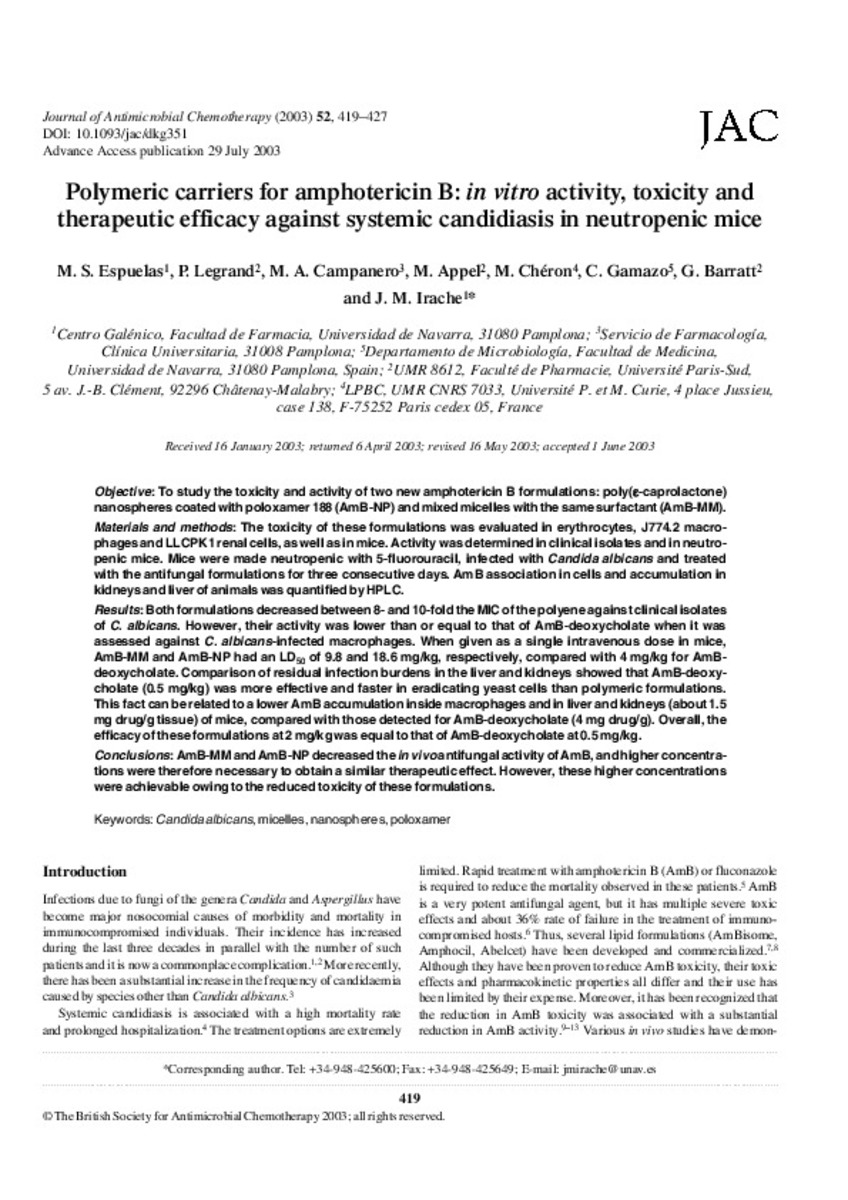Full metadata record
| DC Field | Value | Language |
|---|---|---|
| dc.creator | Espuelas, S. (Socorro) | |
| dc.creator | Legrand, P. (P.) | |
| dc.creator | Campanero, M.A. (Miguel Angel) | |
| dc.creator | Appel, M. (M.) | |
| dc.creator | Cheron, M. (M.) | |
| dc.creator | Gamazo, C. (Carlos) | |
| dc.creator | Barratt, G. (G.) | |
| dc.creator | Irache, J.M. (Juan Manuel) | |
| dc.date.accessioned | 2011-10-22T16:56:52Z | - |
| dc.date.available | 2011-10-22T16:56:52Z | - |
| dc.date.issued | 2003 | - |
| dc.identifier.citation | Espuelas MS, Legrand P, Campanero MA, Appel M, Cheron M, Gamazo C, et al. Polymeric carriers for amphotericin B: In vitro activity, toxicity and therapeutic efficacy against systemic candidiasis in neutropenic mice. J Antimicrob Chemother. 2003 Sep;52(3):419-27. | es_ES |
| dc.identifier.issn | 0305-7453 | - |
| dc.identifier.uri | https://hdl.handle.net/10171/19187 | - |
| dc.description.abstract | Objective: To study the toxicity and activity of two new amphotericin B formulations: poly(ε-caprolactone) nanospheres coated with poloxamer 188 (AmB-NP) and mixed micelles with the same surfactant (AmB-MM). Materials and methods: The toxicity of these formulations was evaluated in erythrocytes, J774.2 macrophages and LLCPK1 renal cells, as well as in mice. Activity was determined in clinical isolates and in neutropenic mice. Mice were made neutropenic with 5-fluorouracil, infected with Candida albicans and treated with the antifungal formulations for three consecutive days. AmB association in cells and accumulation in kidneys and liver of animals was quantified by HPLC. Results: Both formulations decreased between 8- and 10-fold the MIC of the polyene against clinical isolates of C. albicans. However, their activity was lower than or equal to that of AmB-deoxycholate when it was assessed against C. albicans-infected macrophages. When given as a single intravenous dose in mice, AmB-MM and AmB-NP had an LD50 of 9.8 and 18.6 mg/kg, respectively, compared with 4 mg/kg for AmBdeoxycholate. Comparison of residual infection burdens in the liver and kidneys showed that AmB-deoxycholate (0.5 mg/kg) was more effective and faster in eradicating yeast cells than polymeric formulations. This fact can be related to a lower AmB accumulation inside macrophages and in liver and kidneys (about 1.5 mg drug/g tissue) of mice, compared with those detected for AmB-deoxycholate (4 mg drug/g). Overall, the efficacy of these formulations at 2 mg/kg was equal to that of AmB-deoxycholate at 0.5 mg/kg. Conclusions: AmB-MM and AmB-NP decreased the in vivo antifungal activity of AmB, and higher concentrations were therefore necessary to obtain a similar therapeutic effect. However, these higher concentrations were achievable owing to the reduced toxicity of these formulations. | es_ES |
| dc.language.iso | eng | es_ES |
| dc.publisher | Oxford University Press | es_ES |
| dc.rights | info:eu-repo/semantics/openAccess | es_ES |
| dc.subject | Amphotericin B | es_ES |
| dc.subject | Candida albicans | es_ES |
| dc.subject | Micelles | es_ES |
| dc.subject | Nanospheres | es_ES |
| dc.subject | Poloxamer | es_ES |
| dc.title | Polymeric carriers for amphotericin B: in vitro activity, toxicity and therapeutic efficacy against systemic candidiasis in neutropenic mice | es_ES |
| dc.type | info:eu-repo/semantics/article | es_ES |
| dc.identifier.doi | http://dx.doi.org/10.1093/jac/dkg351 | es_ES |
Files in This Item:
Statistics and impact
Items in Dadun are protected by copyright, with all rights reserved, unless otherwise indicated.






